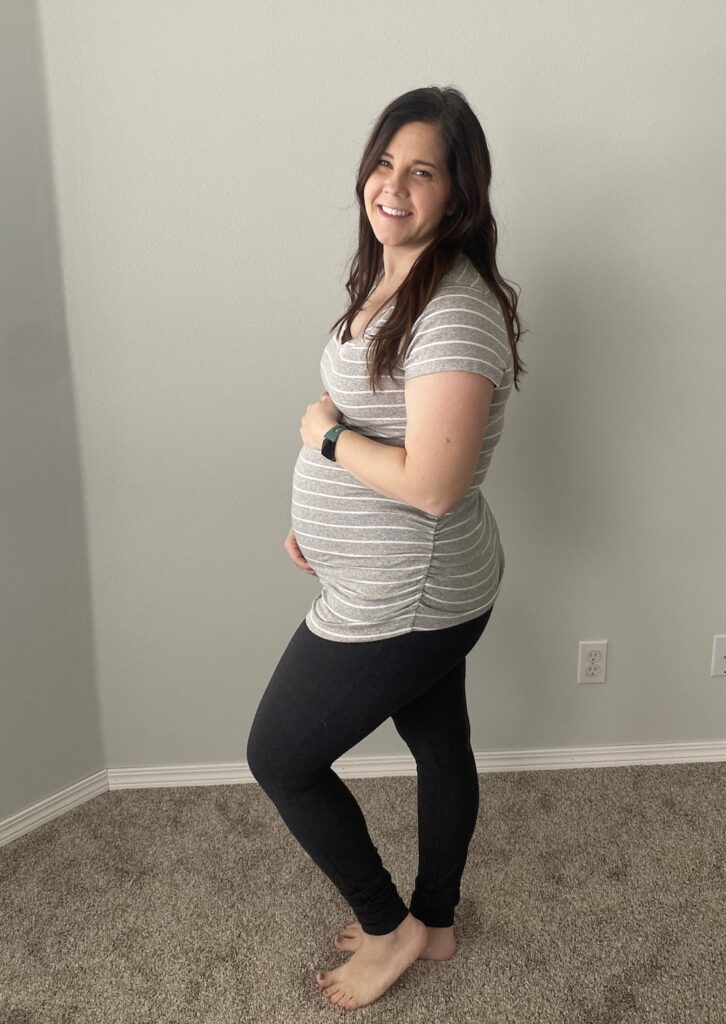Everything you need to check off your second trimester pregnancy checklist to help prepare for your baby, labor, and delivery.
You’ve made it through what is arguably the worst part of pregnancy; the first trimester! Sure, there are challenges associated with any and all parts of pregnancy, but the first trimester nausea, tiredness, and bloating may be behind you!
The second trimester is when most women begin to feel more like themselves and may actually get a little boost of energy (or at the very least don’t feel like they got hit by a train like they might during the first trimester of pregnancy).
It’s also when you may start to tell friends, family, and acquaintances if you haven’t already and your baby bump will likely start showing. Many say the second trimester is the “easiest” trimester of pregnancy (like anything regarding growing a human is easy) and I have to agree!
If you are just starting out in your pregnancy or want to make sure you completed everything from the first trimester, check out this related post: First Trimester Pregnancy Checklist
Here is everything you can check off your second trimester pregnancy checklist, plus a little more of what to expect from a third time mom!
1. Get Some Maternity Clothes
Most mamas will start to get a baby bump around the start of the second trimester. This can vary based your individual body, which pregnancy this is (your first, second, ect.), weight, and other factors. Don’t be worried if you started showing early or if you don’t have a bump yet, both can be completely normal!
During my second pregnancy I had strangers start asking me if I was expecting at just 12-13 weeks along. During my first and third oddly this didn’t happen as fast.
Now is a great time to start looking into maternity clothes! Some women go through most of their pregnancy wearing normal clothes, but I personally prefer to switch to maternity clothes fairly quickly because they are much comfier for me, make me feel better about my changing body, and I want to get the most use out of my new wardrobe as possible!

Amazon Foucome Women’s Maternity Leggings
Here are some of my go-to’s for my maternity wardrobe:
- Maternity Short Sleeve Scoop Neck – affordable, soft, and super comfy! Stock up in a few colors and use on their own or for layering.
- Amazon Foucome Women’s Maternity Leggings – the most buttery soft maternity leggings i’ve tried and they are also super affordable.
- Maternity Nursing Pajama Set – super soft and great for maternity and nursing.
2. Keep up With Low-Impact Exercise
Please always consult with your doctor before starting or changing your exercise program during pregnancy. I am not a physician and am just sharing advice based on my personal experience.
If you felt like crap for your first trimester, now is a great time to start getting a little more active again! Pregnancy is not a great time to start a new workout program or dramatically increase the intensity.
Doing low-impact exercise can have many benefits like decreased weight gain, and increased energy, flexibility, and stamina. Some of my favorites are walking, swimming, and doing barre workouts. I’ve used the MYX Fitness bike for more than a year and am continuing with the floor workouts (mainly barre) during pregnancy. Get $150 off the MYX Fit II with this link: Check Out MYX Fitness Bike
3. Tell Your Friends & Family
A lot of women tend to wait until the second trimester to tell friends & family about their pregnancy. I’ve always waited until 13-16 weeks just because I personally feel more confident making the announcement when chance of miscarriage is lower.
If you haven’t told your friends and family yet, now is a great time! Your growing bump will be harder and harder to hide and you will probably want to start shopping for baby products or start sharing your baby registry/planning your baby shower if you will have one.
4. Find Out The Baby’s Gender

If you are choosing to find out the gender (not everyone does), the start of the second trimester is normally the earliest it can be done via ultrasound. Most providers will schedule an ultrasound around 20 weeks to check on the baby’s anatomy and you will likely be able to find out gender at this time.
Sometimes gender can be determined earlier via an early ultrasound as early as 13-14 weeks. Most doctors won’t order an ultrasound this early, but if you happen to have one or want to see a third-party ultrasound office to find out gender, you will normally need to wait until the second trimester to do so.
Another option to find out your baby’s gender before your 20-week anatomy scan is by doing an at-home gender blood test. We used sneak peek at 16 weeks to find out the gender of our third baby, but you can use Sneak Peek to find out gender as early as 7 weeks! Click here to get $10 off Sneak Peek.
You can also read more about my experience and review here: SneakPeek Review
5. Set Up Your Baby Registry
If you haven’t already, start your baby registry! Its so quick to set up and only takes a few minutes:
Aim to have your baby registry finalized by the end of your second trimester (or a few weeks before your baby shower if you are having one). That way you will have time for your guests to shop and you can also utilize your registry discount coupon that becomes available at the beginning of your third trimester.
Related post: Baby Registry Must Haves
6. Prepare Your Nursery
Your baby doesn’t need much when they are a newborn, but you will probably want a space to store their clothes, change their diapers, and have a crib set up where they will move into eventually. It’s so much harder to build a crib and design a nursery once your baby is here and taking up all your attention, so you will want to get most of this prepped beforehand.
Here are some of my baby registry must-haves including nursery items like a crib, nursery chair, dresser with changing pad. You will want to have a plan on how you will set up your nursery before making your baby registry.
7. Schedule your Anatomy Scan
Most providers, at least here in the US, will have you do an ultrasound around 20 weeks to check the anatomy of your baby and make sure both you and your baby are growing well and developing normally. You don’t need to do much to prepare for this scan, except schedule it at the time recommended by your doctor.
If you don’t know the gender of your baby already (as mentioned above, through either an early scan, blood test, or Sneak Peek at home blood test) this will also be the time you will likely find out your baby’s gender if you choose.
8. Make Healthy Food Choices
During the first trimester most women have nausea and eating becomes simply a form of survival; just eating whatever you can keep down or whatever keeps you from getting nauseous. It was also my experience that hunger strikes hard in the first trimester as you try to keep up with the growing demands of your baby.
During the second trimester it can be a good time to reevaluate your eating habits and hone in on a healthy eating plan to help you gain the appropriate amount of weight during your pregnancy. Aim for a well-balanced diet full of nutritious foods.
Continue to avoid certain foods like raw fish, alcohol, unpasteurized dairy, high-mercury fish, and deli meat (this is not an all inclusive list and be sure to check with your doctor about the most up-to-date and personalized information). Makayla at YoungMommyhood.com also shares a more inclusive and helpful list of foods to avoid during pregnancy.
9. Book a Maternity Photo Shoot
If you plan to have one (I never did, but a lot of women do) start looking for photographers for your maternity photo shoot. Many photographers recommend having maternity photos done between 28-36 weeks, although I personally would opt for earlier before you feel so large and it’s painful to move.
Photographers are often booked out months in advance so it’s important to prepare and plan ahead. You will also want to buy your dress our outfit ahead of time too and be sure to leave extra room for your growing belly.

ChliEarime Hecate Ruffled Chiffon Gown
Highly recommended dress options on Amazon:
- Maternity Off Shoulders Half Circle Gown
- Off Shoulder Maternity Chiffon Gown Split Front
- If you’re looking for something a little “extra” (and that’s totally acceptable when you are pregnant!!): ChliEarime Hecate Ruffled Chiffon Gown
10. Start Looking at Daycares
Most first-time-parents don’t think they need to look at daycares until after their baby is born, but the reality is that a lot of daycares have waiting lists that are months long. With my first son we started checking out daycares in the middle of my pregnancy and were surprised to learn even in our small town the wait list was out a few months.
You really can’t start too soon! If you will need daycare or a nanny, start looking early to make sure you have plenty of options, time to research, and time to get on the waitlist if there is one.
11. Consider your Birth Plan
Most women have a general idea of the way they want to give birth. If you don’t that’s okay too! Now is the time to start researching this and preparing or taking birth classes if necessary.
Some different birthing methods and things to consider are if you would like your birth to be:
- In a hospital, birthing center, or homebirth
- With our without pain medication (or flexible or somewhere in between are options too)
- With or without visitors
You can plan extensively, but also know that most births don’t go exactly as planned. Have some flexibility and prepare for the unexpected.
12. Sign up for a Labor or Birthing Class
It’s a good idea for first time parents especially to take a labor or birthing class to learn what to expect and how to manage some of the labor pains naturally. This is generally done between 25-32 weeks although its never too early or late to start.
Even if you know you want pain medication during labor often times you can’t get pain meds until you are far enough along in the labor process, so knowing some natural techniques will be extremely helpful in managing the pain. It’s also helpful to know what to expect and learn how your body changes as it prepares for and goes through the labor process.
Here are some free labor classes that you can take online. Also be sure to check locally and with your hospital, birthing center, midwife, or doctor for in-person options if you prefer.
Baby Center Childbirth Classes
13. Make a Plan for your Other Children During Labor
If you have other children, consider where they will go and who will care for them while you are in labor. Talk with friends and relatives or consider hiring a nanny or doula that may be able to care for children while you are giving birth.
You can plan for your child to be away at school or for your relative to travel to down during the week of your due-date, but labor can also be unpredictable and you never know if you will go into labor early, in the middle of the night, or before your out-of-town family is able to arrive so its always a good idea to have a backup plan!
14. Prepare for your Glucose Screening Test
Please note, I am not a physician and am just sharing advice based on my personal experience.
Most medical providers will advise that you take a glucose screening test (1 hr glucose test) between 24-28 weeks at the end of your second trimester. This test will screen for gestational diabetes and indicate if you need to take the 3 hr glucose test, which will determine if you actually have gestational diabetes or not.
There is not much you can do physically to prepare for this test, but researching what to expect can help you mentally prepare. Keeping up with a healthy diet and moderate exercise in general can help prevent gestational diabetes, but know that other factors like genetics also play a big part and sometimes gestational diabetes cannot be prevented.
What to expect for the 1 hr glucose screening test? During this test you will be given a drink containing 50g of sugar to drink within 5 minutes.
You will then be required to wait 1 hr and have your blood drawn to check your blood sugar level and determine how your body is processing the glucose. If your blood sugar is above a specific reference range you will be referred to the 3 hr test.
What to expect for the 3 hr glucose test? First, your blood will be drawn at the beginning of the test to determine your fasting blood sugar level. Then you will be given a drink containing 100g of sugar to drink within 5 minutes.
Next, your blood will be drawn at the 1 hour, 2 hour, and 3 hour mark to determine how your body is processing the glucose. If your blood sugar is above a certain reference range for each blood draw you may have gestational diabetes.
Summary of my Second Trimester Pregnancy Checklist
If you missed my first trimester checklist or want to start preparing for the third trimester, be sure to check out these related posts:
- First Trimester Pregnancy Checklist
- Third Trimester Checklist: How To Prepare for a Baby
- Baby Registry Must Haves
If you’re looking for a quick breakdown of everything I recommend to checkoff during your second trimester, here is a summary of everything mentioned above:
- Get some maternity clothes
- Keep up with low-impact exercise
- Tell your friends and family
- Find out the baby’s gender
- Set up your baby registry
- Prepare your nursery
- Schedule your anatomy scan
- Make healthy food choices
- Book a maternity photo shoot
- Start looking at daycares
- Consider a birth plan
- Sign up for labor or birthing classes
- Make a plan for your other children during labor
- Prepare for your glucose screening test
You might also like these recent posts:
- Top 60 Amazon Baby Registry Must-Haves for New Parents
- Easy Summer Lunch Ideas for Kids: 3 Fun & Time-Saving Meals Moms Will Love
- Kid-Friendly Blender Cottage Cheese Pancakes (Hulk Pancakes!)
- 3 Must-Have Items for Potty Training Your Toddler
- 9 Easy Toddler Sensory Activities

